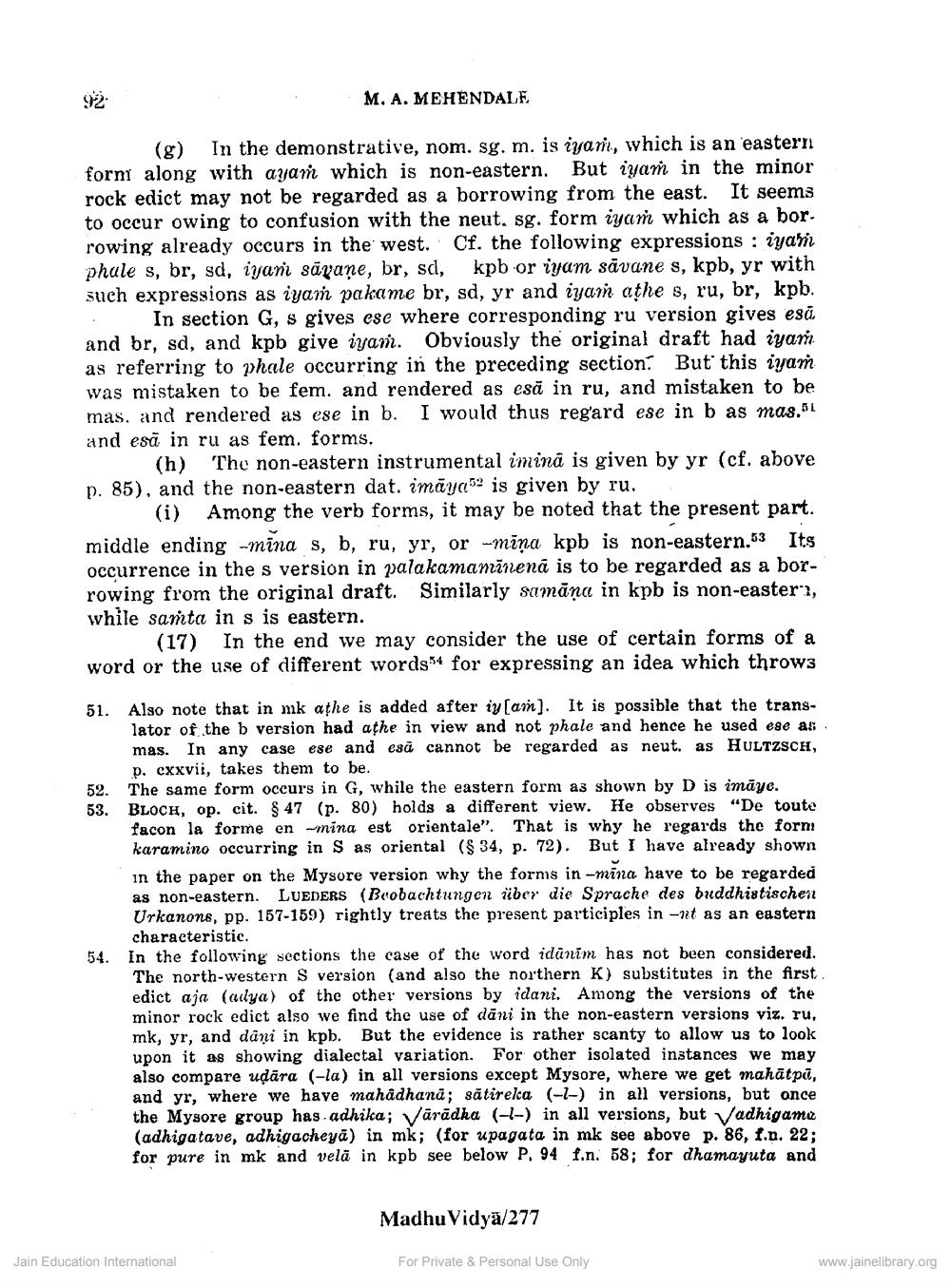________________
92
M. A. MEHENDALE
(g) In the demonstrative, nom. sg. m. is iyan, which is an eastern form along with ayam which is non-eastern. But iyam in the minor It seems rock edict may not be regarded as a borrowing from the east. to occur owing to confusion with the neut. sg. form iyam which as a bor. rowing already occurs in the west. Cf. the following expressions: iyam phule s, br, sd, iyam sägane, br, sd, kpb or iyam savane s, kpb, yr with such expressions as iyam pakame br, sd, yr and iyam athe s, ru, br, kpb. In section G, s gives ese where corresponding ru version gives esa and br, ad, and kpb give iyam. Obviously the original draft had iyari as referring to phale occurring in the preceding section. But this iyam was mistaken to be fem. and rendered as esd in ru, and mistaken to be mas. and rendered as ese in b. I would thus regard ese in b as mas.51 and esă in ru as fem. forms.
(h) The non-eastern instrumental imină is given by yr (cf. above p. 85), and the non-eastern dat. imaya is given by ru.
Its
(i) Among the verb forms, it may be noted that the present part. middle ending mina s, b, ru, yr, or mina kpb is non-eastern.53 occurrence in the s version in palakamaminena is to be regarded as a borrowing from the original draft. Similarly samāna in kpb is non-easter, while samta in s is eastern.
(17) In the end we may consider the use of certain forms of a word or the use of different words" for expressing an idea which throws
51. Also note that in mk athe is added after iy [am]. It is possible that the translator of the b version had athe in view and not phale and hence he used ese as mas. In any case ese and esa cannot be regarded as neut. as HULTZSCH, p. cxxvii, takes them to be.
52. The same form occurs in G, while the eastern form as shown by D is imāye. 53. BLOCH, op. cit. § 47 (p. 80) holds a different view. He observes "De toute facon la forme en mina est orientale". That is why he regards the form karamino occurring in S as oriental (§ 34, p. 72). But I have already shown in the paper on the Mysore version why the forms in -mina have to be regarded as non-eastern. LUEDERS (Beobachtungen über die Sprache des buddhistischen Urkanons, pp. 157-159) rightly treats the present participles in -nt as an eastern characteristic.
54. In the following sections the case of the word idanim has not been considered. The north-western S version (and also the northern K) substitutes in the first. edict aja (adya) of the other versions by idani. Among the versions of the minor rock edict also we find the use of dani in the non-eastern versions viz. ru, mk, yr, and dani in kpb. But the evidence is rather scanty to allow us to look upon it as showing dialectal variation. For other isolated instances we may also compare uḍāra (-la) in all versions except Mysore, where we get mahātpā, and yr, where we have mahadhanā; satireka (--) in all versions, but once the Mysore group has adhika; Värädha (--) in all versions, but Vadhigame (adhigatave, adhigacheya) in mk; (for upagata in mk see above p. 86, f.n. 22; for pure in mk and vela in kpb see below P. 94 f.n. 58; for dhamayuta and
Jain Education International
Madhu Vidya/277
For Private & Personal Use Only
www.jainelibrary.org




